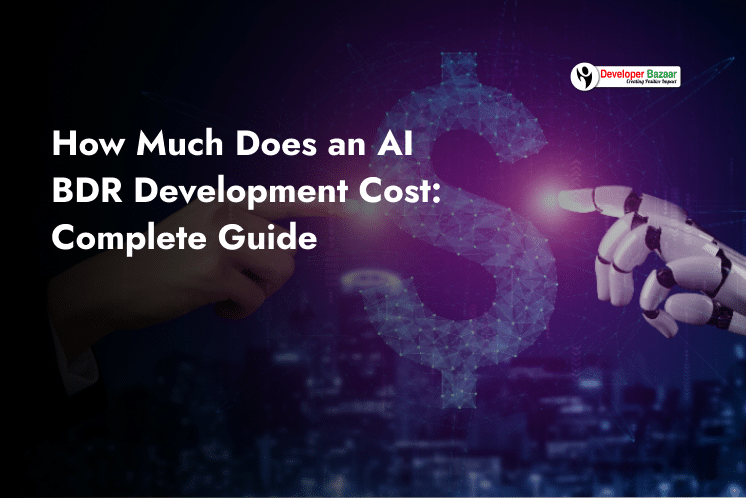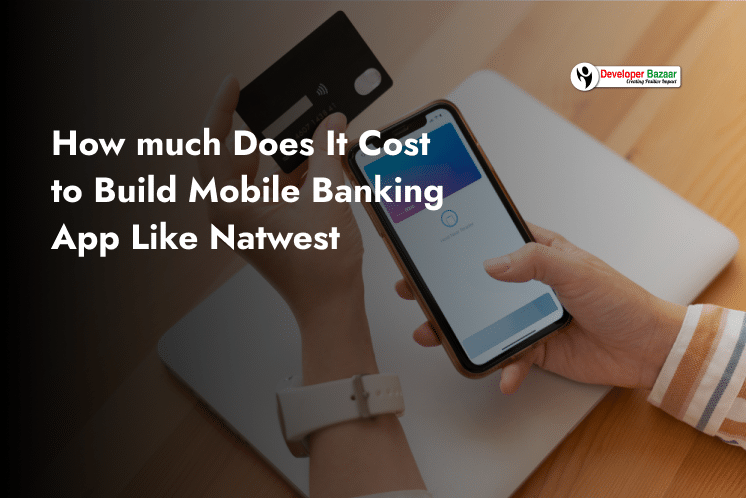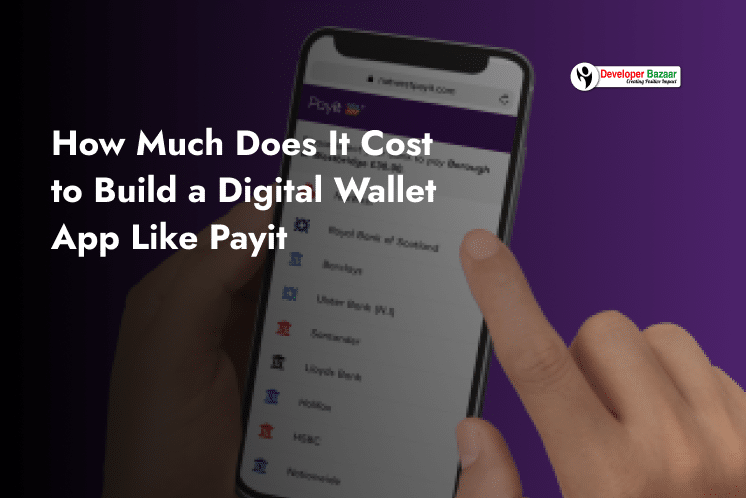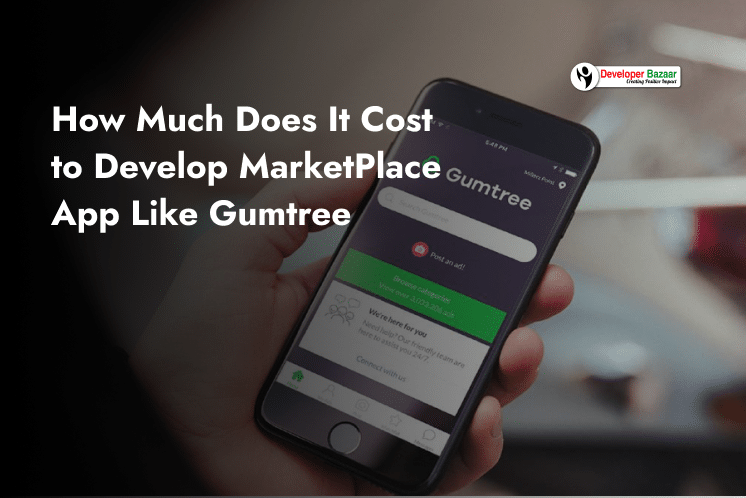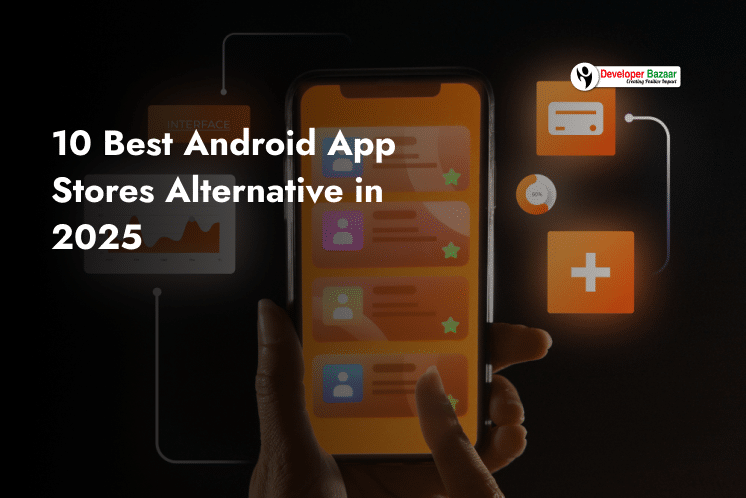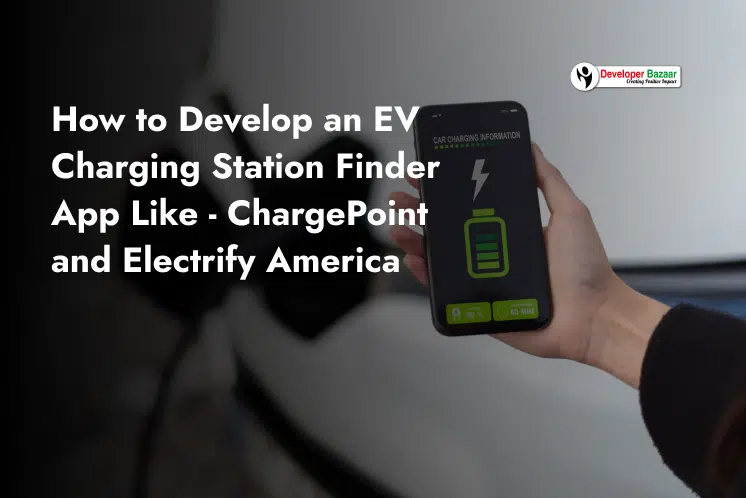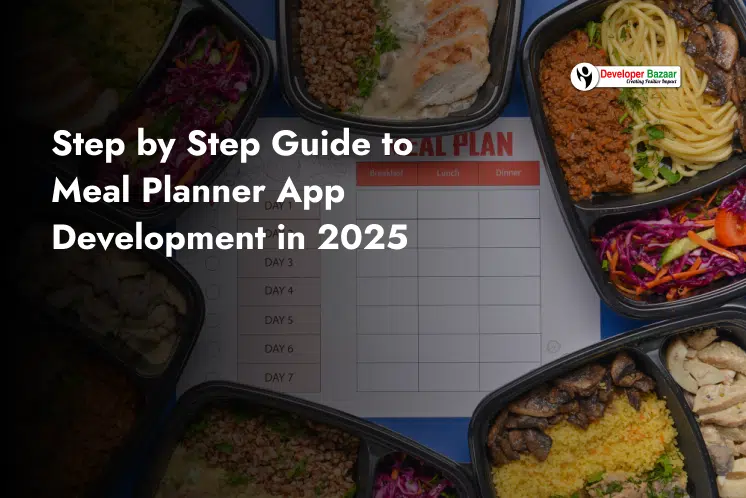Table of Contents
ToggleIn today’s competitive business landscape, companies are constantly searching for smarter ways to generate leads and close deals. That’s where AI BDRs come in. These AI-driven business development representatives handle repetitive sales tasks, allowing human teams to focus on closing deals.
But how much does AI BDR development cost? The answer depends on several factors, including the complexity of the AI system, integration with existing tools, and customization needs.
This guide breaks down everything you need to know about AI BDR development—from understanding what an AI BDR does to how it fits into your outbound sales process. By the end, you’ll have a clear picture of how to build an AI BDR and whether it’s the right investment for your business.
What is an AI BDR and How Does It Work?
Imagine having a super-smart assistant that helps your sales team find new customers. That’s exactly what an AI BDR (Artificial Intelligence Business Development Representative) does! It’s like a digital salesperson that works 24/7, handling boring and repetitive tasks so your team can focus on closing deals.
Instead of spending hours sending emails, searching for leads, and following up with potential customers, an AI BDR does it all automatically. It helps businesses find the right people, reach out to them, and figure out who is interested in buying.
How Does Work?
An AI BDR (Artificial Intelligence Business Development Representative) is like a smart assistant that helps businesses find and connect with potential customers. It does this using AI tools that search, analyze, and communicate with leads automatically.
Many businesses still don’t fully understand or use AI BDRs, which means it’s a great time to start. Think of it like investing in Bitcoin in 2009, early adopters gain a big advantage!
1. Finding and Researching Leads
AI BDRs are like detectives, scanning websites, social media, company databases, and CRM systems to gather useful details about businesses and their employees. They collect information such as company names, industries, and sizes, as well as key decision-makers like CEOs, managers, and sales reps.
They also look for job titles, responsibilities, and common company challenges. With this information, AI BDRs build a list of potential customers that match your ideal audience.
2. Picking the Best Prospects
Not every lead is fit for the business. AI BDR filters out weak leads and keeps only the best ones. It checks company size, location, and industry to ensure the lead aligns with your target market.
Additionally, it analyzes past purchases or engagement history and identifies businesses actively looking for solutions like yours. By narrowing down the list, AI BDRs save your sales team time and ensure they focus only on high-quality leads.
3. Creating Personalized Messages
AI BDRs don’t send generic, copy-paste emails. Instead, they craft personalized messages based on what they know about each prospect. They might mention recent company news, awards, or events to grab attention.
They also highlight common industry challenges the prospect might be facing and use the person’s name and role to make the message feel more engaging. This personal touch makes outreach feel natural and increases the chances of getting a response.
4. Sending Messages at the Right Time
Timing is everything in sales! AI BDRs analyze data to determine when a prospect is most likely to open an email or respond to a message.
They track when the person usually engages with emails, consider their time zone and work hours, and identify the best days of the week for outreach. By sending messages at the perfect moment, AI BDRs improve response rates and make outreach more effective.
5. Tracking Responses and Following Up
AI BDRs don’t just send messages and forget about them—they track responses and take action based on what happens next. They monitor whether the prospect opens the email, clicks on a link, or replies to the message.
If the prospect doesn’t respond, AI follows up automatically with a polite reminder. This ensures that no potential lead is forgotten and increases the chances of getting a reply.
6. Qualifying Leads
Not all interested leads are ready to buy. AI BDRs analyze responses to determine how serious a prospect is.
They assess the tone and urgency of the reply, check if the prospect asks questions about pricing or features, and identify whether they need more information before making a decision. If a lead shows high interest, AI marks them as ready for a sales call.
7. Handing Over Leads to the Sales Team
Once AI BDR finds and qualifies a potential customer, it hands them over to a human sales rep. It also provides all the collected data, ensuring that the sales team knows exactly what the prospect is interested in.
Sales reps receive important details such as the prospect’s name, job title, and company information, along with their past interactions and engagement history. With this information, sales teams can start conversations confidently and close deals faster.
AI BDR vs. AI SDR: Key Differences Explained
Both AI BDRs and AI SDRs help businesses grow, but they focus on different parts of the sales process.
An AI BDR (Business Development Representative) is responsible for finding and connecting with potential customers. It researches leads by gathering important details and then sends personalized outreach messages.
AI BDRs also identify and qualify leads before passing them to the sales team, ensuring that only the best opportunities move forward. Think of AI BDRs as scouts—they explore new markets and bring back fresh leads.
On the other hand, an AI SDR (Sales Development Representative) focuses on engaging with leads and determining if they are a good fit for the company. AI SDRs respond to leads, answer their questions, and schedule calls or meetings with sales reps.
They also track interactions and analyze responses to ensure that only high-quality leads reach the sales team. By automating follow-ups and analyzing engagement, AI SDRs make the qualification process smoother and more effective.
The Role of AI BDR in Your Outbound Sales Strategy
AI BDRs are changing how businesses approach outbound sales. Instead of spending hours researching and reaching out to potential customers, sales teams can now rely on AI to handle these repetitive tasks.
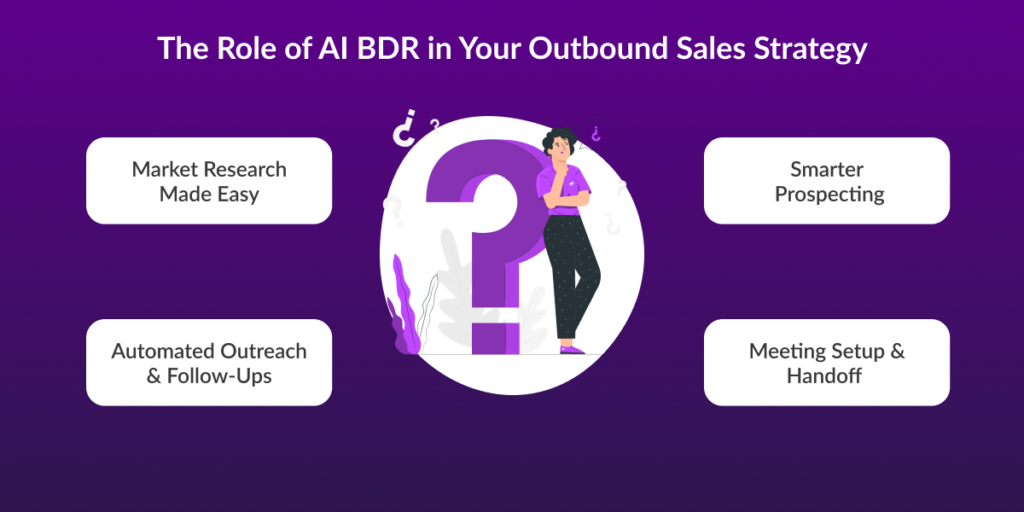
1. Market Research Made Easy
Before reaching out to potential customers, businesses need to understand their market. AI BDRs make this process faster and more accurate.
They analyze large amounts of data to map the Total Addressable Market (TAM) and segment potential customers based on industry, company size, and buying intent. AI also identifies untapped opportunities that human reps might miss.
2. Smarter Prospecting
Finding the right prospects can be time-consuming. AI BDRs automate list-building by analyzing existing customers, finding similar businesses, and collecting contact details.
They also research accounts and provide real-time insights, such as company growth, leadership changes, and funding updates. This ensures sales teams focus only on high-quality leads.
3. Automated Outreach & Follow-Ups
Cold emails, LinkedIn messages, and follow-ups take up a lot of time. AI BDRs personalize emails based on recent news, job changes, or company updates.
They also send follow-ups at the right time based on engagement data, ensuring no lead is forgotten.
4. Meeting Setup & Handoff
Once a lead is interested, AI BDRs handle scheduling. They check calendars, suggest available slots, and even reschedule meetings if needed.
Before handing off a lead to a human rep, AI provides a full summary of past interactions, making the transition smooth and efficient.
How’s an AI BDR Different From a Human BDR?
AI BDRs and human BDRs both help businesses grow, but they work in different ways.
Here’s a quick comparison:
| Feature | AI BDR | Human BDR |
|---|---|---|
| Speed & Scale | Researches thousands of prospects and sends messages in minutes. | Works one prospect at a time, limited by human capacity. |
| Personalization | Uses data to customize outreach at scale. | Builds deeper relationships but at a slower pace. |
| Consistency | Always follows up on time, avoids typos, and maintains perfect timing. | May forget follow-ups or make mistakes. |
| Learning & Adapting | Improves based on data from past interactions. | Learns from experience but may not always share insights with the team. |
| Handling Conversations | Answers FAQs, schedules meetings, and sends updates. | Handles complex discussions and emotional interactions better. |
| Cost & Availability | Works 24/7, costs less over time, and doesn’t need breaks. | Works regular hours and requires a salary, but can form stronger connections. |
While AI BDRs handle repetitive tasks more efficiently, human BDRs excel at relationship-building and complex sales conversations. The best approach is a mix of both—AI handles prospecting and follow-ups, while human reps focus on closing deals.
How To Integrating AI BDRs With Your Business Strategy?
AI BDRs can help businesses save time, work more efficiently, and increase sales. But before using AI, it’s important to check if it fits your needs, choose the right tool, and plan the process carefully.
1. How to Assess Your Needs
To see if AI BDRs are right for your business, start by looking at what tasks take up the most time for your team.
Ask yourself: Are there repetitive tasks that AI can handle? Can AI help find and qualify leads faster? Are there communication delays that AI can fix?
If your team spends too much time on research, outreach, and follow-ups, AI can be a game-changer. It allows your team to focus on more valuable tasks while AI handles routine work.
2. How to Choose the Right AI BDR Tool
When picking an AI BDR tool, make sure it meets your business needs and works well with your existing systems. The tool should be able to grow with your business and integrate with your CRM.
Also, check if the provider offers support and training to help your team adapt. Some AI tools, like 6sense, provide smart solutions for sales and marketing. These include AI-powered marketing, sales intelligence, and automated emails to improve business development.
3. How to Implement AI BDRs
Step 1: Assess Your Current Processes
Start by identifying tasks that take up a lot of time but add little value, like data entry and follow-ups. Check how your team handles these tasks and find areas where AI can help. This will give you a clear idea of what needs improvement. It’s also a good idea to get input from your team to understand their challenges and concerns.
Step 2: Choose the Best AI BDR Tool
List the most important features you need, such as lead scoring, data analysis, and automation. Compare different AI BDR tools to see which one fits your business best. Look for tools that can scale as your business grows. If possible, request demos or free trials to test how well they work.
Step 3: Start with a Small Test
Before rolling out AI to your entire team, start with a small test. Use the AI tool in a limited area and monitor the results. This helps identify any problems and make improvements before full integration.
Step 4: Train Your Team
Your team needs to know how to use AI effectively. Train them on how to read AI-generated data, personalize outreach, and balance automation with human interaction. Real-life examples and hands-on practice will help them adapt quickly.
Step 5: Fully Integrate AI BDRs
Once testing and training are done, AI BDRs can be fully added to daily operations. Businesses can use AI-powered tools on their websites to engage visitors in real time, making it easier to convert leads into customers.
Step 6: Keep Monitoring and Improving
AI gets better over time, but it still needs regular monitoring. Keep track of key metrics like response rates, lead conversions, and overall sales growth. Updating AI with fresh data and making adjustments will ensure it stays effective and aligned with your business goals.
By following these steps, businesses can successfully integrate AI BDRs and improve their sales process without losing the human touch.
How Much Does an AI BDR Development Cost?
The cost to develop an AI BDR can range from $30,000 to $200,000 or more. The final cost depends on the features, complexity, and data requirements.
Below is a breakdown of different factors that affect AI BDR development costs:
Factors Affecting AI BDR Development Cost
| Factor | Impact on Cost |
|---|---|
| AI Features | Simple AI functions like lead scoring are cheaper than advanced AI with predictive analytics. |
| Data Requirements | More data and complex AI training increase costs. |
| Integration Complexity | Connecting AI with CRM and marketing tools adds to the expense. |
| Development Team | Hiring AI engineers and data scientists costs more but ensures better quality. |
| Customization | A fully custom AI BDR is costlier than using pre-built AI frameworks. |
| Scalability | AI that can grow with your business may have higher upfront costs. |
| Industry-Specific Needs | Some industries require special AI models, increasing costs. |
| Project Timeline | Longer projects cost more due to extended development work. |
Estimated Cost Based on AI BDR Features
| AI Feature | Estimated Cost |
|---|---|
| Basic AI-powered lead scoring | $20,000 – $50,000 |
| AI-driven chatbot for BDRs | $30,000 – $80,000 |
| Personalized email outreach with AI | $40,000 – $100,000 |
| Predictive analytics for BDRs | $50,000 – $150,000 |
| Advanced AI-powered BDR platform | $100,000+ |
Tips to Reduce AI BDR Development Cost
- Prioritize important features – Focus on what delivers the most value.
- Use pre-built AI platforms – Ready-made AI tools can cut costs.
- Work with AI experts – Partnering with an experienced artificial intelligence development company ensures quality.
- Use open-source tools – Free AI libraries reduce licensing costs.
- Negotiate pricing – EnsureAlways discuss costs with AI developers.
The Benefits of Using AI BDRs for Sales Teams and Businesses
There are following benefits of using AI BDRs for business:
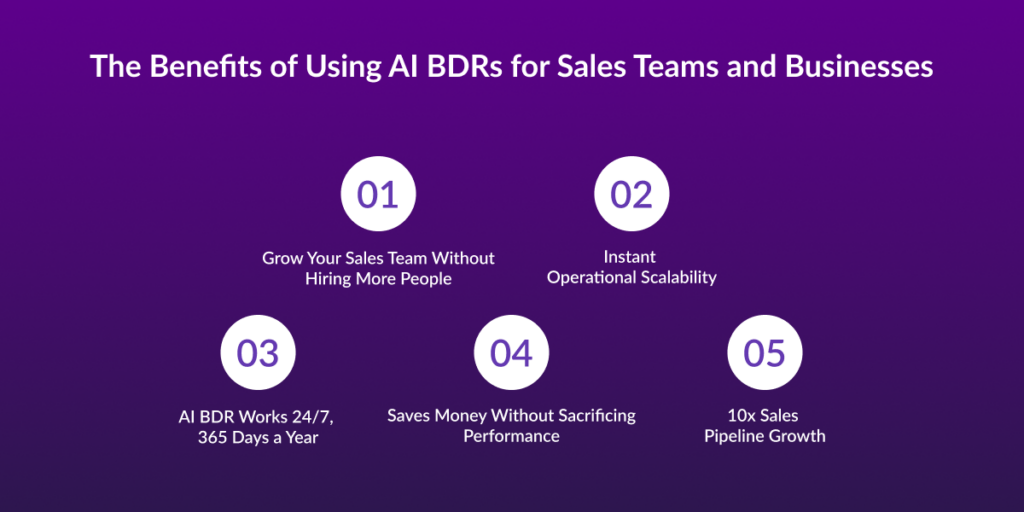
1. Grow Your Sales Team Without Hiring More People
AI BDRs handle prospecting, follow-ups, and outreach without increasing headcount. Businesses can scale sales efforts without worrying about hiring and managing a larger team.
2. Instant Operational Scalability
Unlike human reps, AI BDRs don’t need training time. They start working immediately and manage large volumes of outreach from day one. This helps startups and enterprises scale quickly.
3. AI BDR Works 24/7, 365 Days a Year
AI never takes breaks. It engages prospects at all hours, across different time zones, ensuring no opportunity is missed. Whether it’s a holiday or late at night, your AI BDR keeps working.
4. Saves Money Without Sacrificing Performance
AI BDRs reduce the need for a large sales team. Businesses can save money on hiring, salaries, and training while maintaining a high level of lead generation and engagement.
5. 10x Sales Pipeline Growth
AI BDRs automate repetitive tasks, freeing up human reps to focus on high-value conversations. This leads to a 10x increase in pipeline growth, helping businesses generate more qualified leads and close deals faster.
Who Should Use AI BDR?
AI BDRs are perfect for businesses and teams that need faster, smarter, and more efficient sales processes.
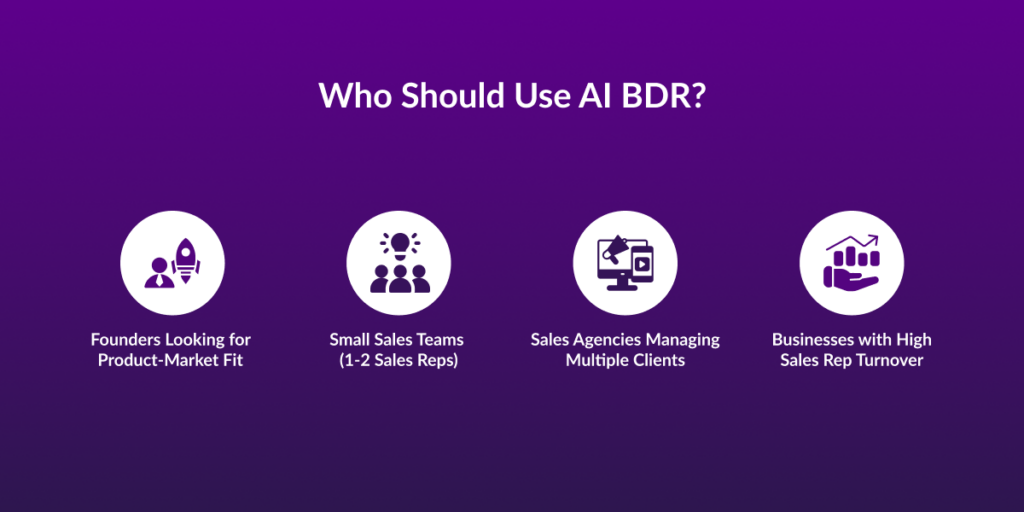
1. Founders Looking for Product-Market Fit
Startups need fast lead generation but have limited time and resources. AI BDRs automate outreach, helping founders validate their messaging and attract early customers without spending hours on sales.
2. Small Sales Teams (1-2 Sales Reps)
When a small sales team handles everything from prospecting to closing deals, it can be overwhelming. AI BDRs take care of repetitive tasks, allowing human reps to focus on important conversations and closing more deals.
3. Sales Agencies Managing Multiple Clients
Sales agencies handle different clients with different needs. AI BDRs help maintain personalized outreach at scale, improving efficiency and allowing agencies to serve more clients without hiring extra staff.
4. Businesses with High Sales Rep Turnover
Frequent sales rep turnover can disrupt the pipeline and increase training costs. AI BDRs provide a consistent sales development process, ensuring business continuity even when human reps leave.
Top 5 AI BDR Tools to Boost Your Sales Efficiency
AI-powered Business Development Representatives (BDRs) can transform your sales process. They save time, automate lead generation, and improve outreach. But with so many AI BDR tools available, choosing the right one can be tough. Here are the top five AI BDR tools to help your business grow.
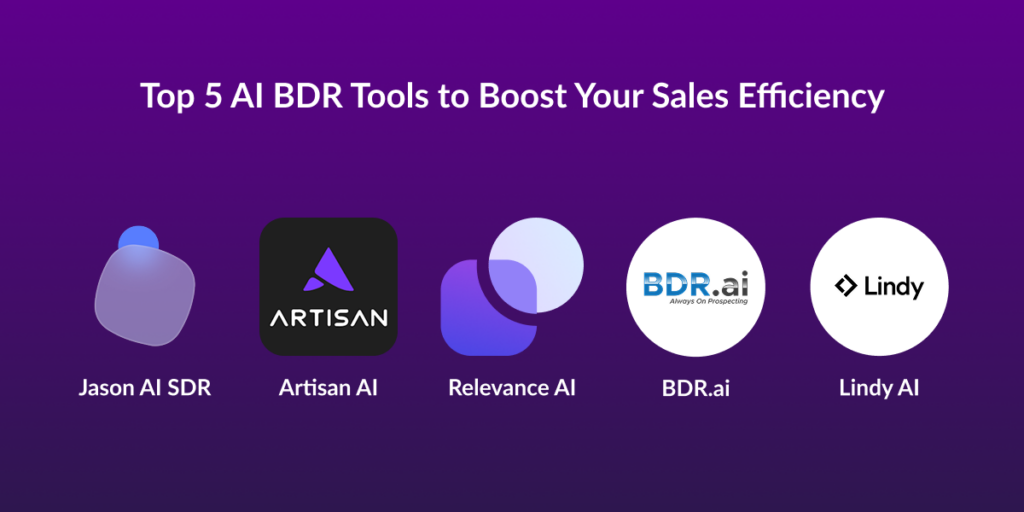
1. Jason AI SDR
Jason AI SDR by Reply.io is like a super-efficient sales assistant. It helps find the right leads, engage them across multiple channels, and even book meetings for you.
Key Features:
- AI-powered personalization
- Multilingual and multi-channel outreach
- Automated meeting scheduling
- Instant reply handling
- LinkedIn personalization
Why Choose Jason AI SDR?
Jason works 24/7, ensuring your pipeline stays full. It’s a cost-effective alternative to hiring a full sales team.
2. Artisan AI
Artisan AI helps BDRs engage with leads in a meaningful way. It learns from past interactions to improve communication and increase conversions.
Key Features:
- AI-driven lead discovery
- Smart email personalization
- Automated follow-ups
- Meeting booking
Why Try Artisan AI?
3. Relevance AI
Relevance AI analyzes sales data to find the best prospects and suggest the right outreach strategies.
Key Features:
- AI-powered data insights
- No-code AI workforce builder
- Custom AI agent creation
- CRM integration
Why Use Relevance AI?
It helps teams understand their audience better and make data-driven decisions for better results.
4. BDR.ai
BDR.ai focuses on making lead generation simple. It automates outreach and follow-ups, keeping your sales team focused on closing deals.
Key Features:
- Automated lead management
- Email and messaging automation
- Easy CRM integration
- Task automation
Why Choose BDR.ai?
It’s user-friendly and perfect for teams that need automation without the complexity.
5. Lindy AI
Lindy AI specializes in conversational AI. It creates human-like interactions to improve engagement with leads.
Key Features:
- Custom AI sales assistants
- AI-driven scheduling and outreach
- Resume screening for hiring
- CRM and knowledge base integration
Why Go With Lindy AI?
It makes AI conversations feel natural, helping sales teams connect better with potential clients.
What Are the Challenges With AI BDRs?
AI BDRs bring many benefits, but they also have some challenges.
- Lack of Human Touch: AI can sound robotic. It may not handle emotions and complex conversations as well as humans.
- Data Quality Issues: AI depends on good data. If the data is incorrect or incomplete, the AI will not perform well.
- Integration Difficulties: AI tools must work smoothly with existing CRM systems and sales processes. Otherwise, they can slow down operations.
- Trust Issues: Some customers prefer speaking with a human. Businesses need to balance AI automation with human interaction.
What Is the Future of AI in Business Development?
The future of AI BDRs looks promising, with several advancements on the way.
- More Businesses Adopting AI Sales Tools: AI use in sales is growing fast. High-performing teams are 2.8 times more likely to use AI.
- Better Predictive Analytics: AI will get better at predicting customer behavior, helping sales teams target the right leads at the right time.
- Smarter AI Agents: AI will become more conversational and human-like, improving customer interactions.
- Simplify AI-Human Collaboration: Future AI BDRs will work alongside sales teams, handling repetitive tasks while humans focus on strategy and relationships.
Conclusion
Traditional BDR teams can only handle so much. AI BDRs allow businesses to scale quickly, automate repetitive tasks, and improve efficiency.
Partner with professional Artificial Intelligence development company to develop the right AI BDR tool, you can generate leads, engage prospects, and close deals faster.
FAQs
Q 1. How long does it take to develop an AI BDR System?
A: Development Time can Vary from a few months to over a year, depending on the project’s Scope and customization.
Q 2. Is AI BDR development expensive for small businesses?
A: Initial costs can be high, many small businesses can benefit from scalable solutions, offering cost-effective options over time.
Q 3. How can I reduce the cost of developing an AI BDR system?
A: By using pre-built AI platforms or opting for modular solutions can significantly reduce development cost and time.
Q 4. How do you Choose between in-house development or outsourcing AI BDR creation?
A: In-house development offers more control but it is more costly, while outsourcing can reduce costs and speed up the development process.
Q 5. Can AI BDR systems be scaled as the business grows?
A: Yes, AI BDR systems can be designed to scale, allowing businesses to handle more leads and data as they expand.

RM Mishra
Co-Founder
Developer Bazaar technologies
